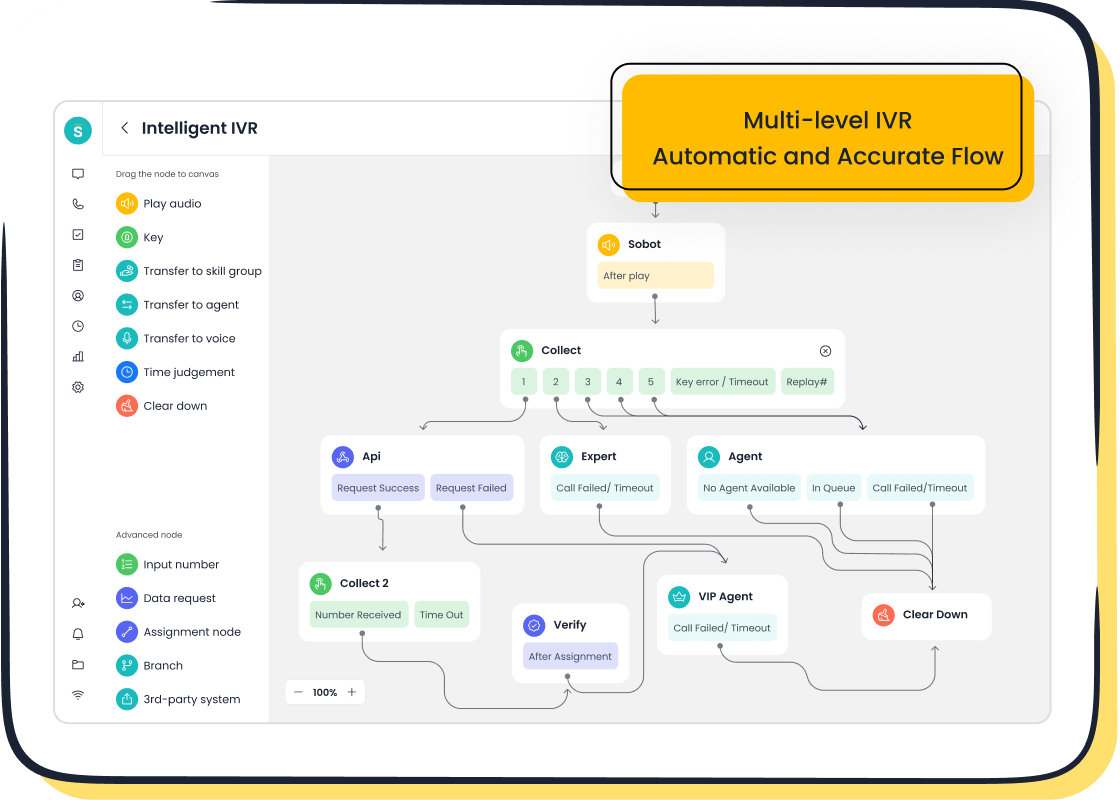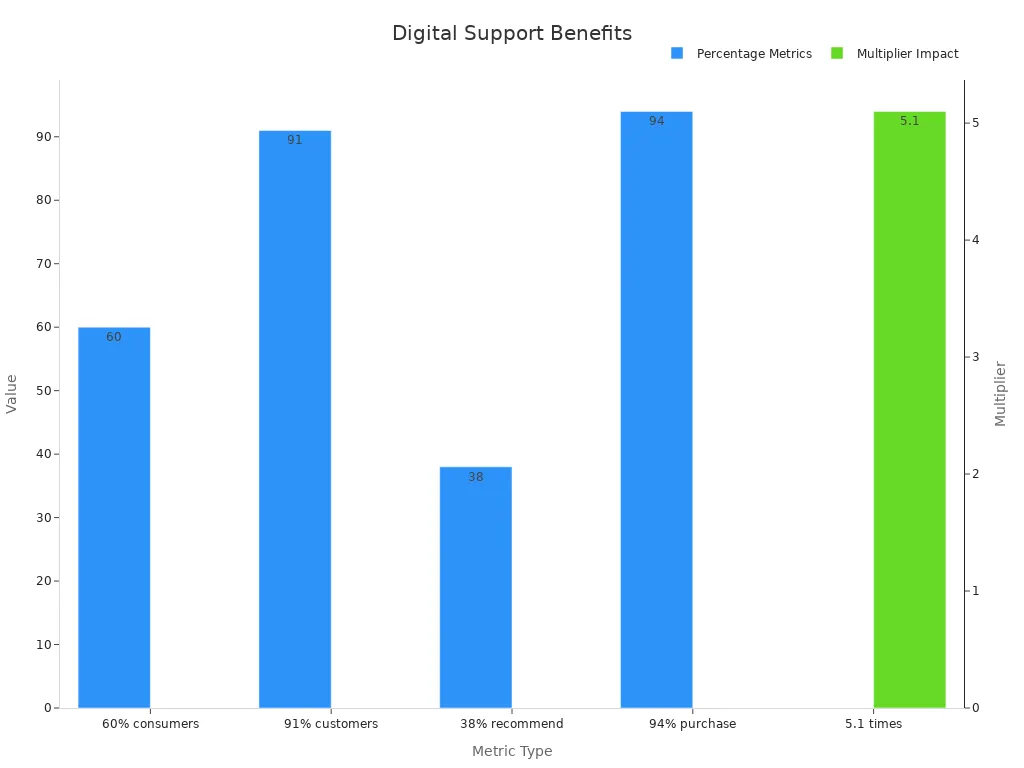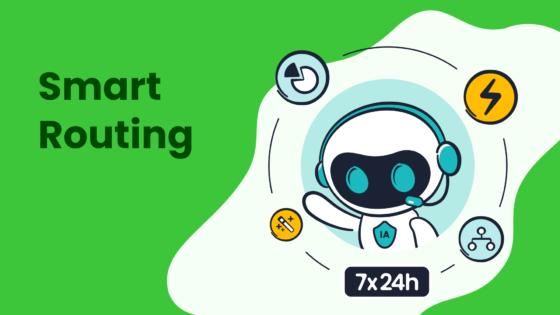Understanding Customer Support Systems and Their Types

In today’s competitive market, customer support systems help businesses deliver excellent service. These systems streamline communication between you and your customers, ensuring quick resolutions and personalized interactions. Their importance becomes clear when you consider the numbers. For example:
- A 5% increase in customer retention can boost profits by up to 95%.
- Effective support strategies often lead to a 15% rise in customer satisfaction.
Sobot, a leader in this field, offers innovative solutions like AI-powered chatbots, ticketing systems, and omnichannel platforms. These tools enhance efficiency and help you meet customer expectations effortlessly.
What Are Customer Support Systems?
Definition and Purpose
Customer support systems are tools or platforms designed to help businesses manage and enhance their interactions with customers. These systems streamline communication, track customer inquiries, and provide solutions efficiently. Their primary purpose is to ensure that customers receive timely and satisfactory assistance, which directly impacts their loyalty and trust in your brand.
For example, Sobot’s omnichannel solution integrates various communication channels like email, social media, and live chat into a unified workspace. This allows you to manage customer interactions seamlessly, ensuring no query goes unanswered. By using such systems, you can reduce response times and improve the overall customer experience.
Key Features of Customer Support Systems
Effective customer support systems come equipped with several essential features that enhance their functionality. These include:
- Intelligent Routing: Automatically directs customer inquiries to the right agent or department, reducing wait times and improving satisfaction.
- Case Management: Ensures that every customer issue is tracked and resolved efficiently, minimizing the chances of unresolved tickets.
- Self-Service Portals: Empower customers to find answers independently through FAQs or knowledge bases, saving time for both parties.
- Multi-Channel Support: Allows you to interact with customers across various platforms, ensuring a consistent experience.
- Reporting and Analytics: Provides insights into performance metrics like resolution time and customer satisfaction scores, helping you identify areas for improvement.
| Feature | Description |
|---|---|
| Intelligent Routing | Automatically directs communication to the appropriate personnel, enhancing customer experience. |
| Case Management | Streamlines the resolution process and reduces the chances of tickets going missing. |
| Self-Service Portal | Provides customers with a resource to resolve issues quickly, enhancing efficiency. |
| Knowledge Management | Houses information in an easily navigable format for quick access by users. |
| Multi-Channel Support | Collects feedback from various platforms, allowing for broader issue resolution. |
| Reporting and Analytics | Utilizes data to identify and improve troublesome areas in customer support. |
Sobot’s solutions, such as its AI-powered chatbot and ticketing system, incorporate these features to deliver exceptional service. For instance, the chatbot resolves repetitive queries, while the ticketing system ensures complex issues are handled effectively.
Importance of Customer Support Systems for Businesses
Customer support systems play a crucial role in driving business success. They not only improve operational efficiency but also enhance customer satisfaction, which directly impacts your bottom line. Consider these metrics:
- Customer Retention Rate: A higher retention rate indicates that your customers are satisfied and loyal. Retaining customers is more cost-effective than acquiring new ones.
- Resolution Time: Faster resolutions lead to happier customers. Studies show that 73% of customers prioritize quick issue resolution.
- Customer Satisfaction Score (CSAT): This metric reflects how well your support system meets customer expectations.
| Metric | Description |
|---|---|
| Customer Retention Rate | Measures the percentage of customers retained over a period, indicating operational efficiency. |
| Resolution Time | The time taken to resolve customer issues, crucial for customer satisfaction. |
| Customer Satisfaction Score | Gauges customer satisfaction with services, reflecting overall service quality and efficiency. |
By implementing a robust system like Sobot’s Cloud Call Center, you can achieve a 99.99% system uptime, ensuring uninterrupted service. This stability, combined with features like intelligent IVR and AI-powered voicebots, helps you reduce average handle time and increase first-contact resolution rates. These improvements not only boost customer satisfaction but also contribute to long-term business growth.
Tip: Monitoring metrics like Net Promoter Score (NPS) and analyzing sales performance before and after adopting a customer support system can provide valuable insights into its impact on your business.
Traditional Customer Support Systems
Phone-Based Support
Phone-based support remains one of the oldest and most reliable methods of customer service. It allows you to connect directly with customers, offering a personal touch that many people value. This method is especially effective for resolving complex issues that require detailed explanations or immediate assistance. For example, if a customer faces a technical issue with a product, a phone call can provide step-by-step guidance to resolve it quickly.

Sobot’s Cloud Call Center enhances traditional phone support by integrating advanced features like intelligent IVR and AI-powered voicebots. These tools streamline call routing and reduce wait times, ensuring your customers receive prompt and efficient service. With global number availability and a 99.99% system uptime, Sobot ensures uninterrupted communication, even during peak hours.
Email Support
Email support is another widely used traditional method. It provides a written record of communication, which is useful for tracking and resolving customer issues. This method works well for non-urgent inquiries or when customers need to share detailed information, such as documents or screenshots.
Sobot’s ticketing system takes email support to the next level by automating workflows and managing SLAs. It ensures that every email is converted into a ticket, tracked, and resolved efficiently. This system helps you maintain consistency and prevents customer queries from slipping through the cracks.
Advantages and Limitations of Traditional Systems
Traditional customer support systems offer several benefits but also come with limitations. The table below highlights these aspects:
| Advantages | Limitations |
|---|---|
| Consistency in Responses | Limited Flexibility |
| Scalability | Dependency on Predefined Workflows |
| Cost-Effectiveness | Potential for Customer Frustration |
While traditional systems like phone and email support provide consistency and scalability, they often lack the flexibility needed to adapt to modern customer expectations. For instance, predefined workflows may not accommodate unique customer needs, leading to frustration. However, integrating these systems with advanced tools like Sobot’s solutions can help you overcome these challenges and deliver a superior customer experience.
Tip: Combining traditional methods with digital tools can create a balanced approach, ensuring you meet diverse customer needs effectively.
Digital Customer Support Systems

Live Chat Support
Live chat support has become a cornerstone of modern customer support systems. It allows you to engage with customers in real time, providing instant solutions to their queries. This immediacy enhances customer satisfaction and builds trust. Studies show that live chat is the preferred digital channel for self-service among 52% of customers. Additionally, businesses using live chat report a 40% increase in conversion rates, demonstrating its effectiveness in driving sales.
The benefits of live chat support extend beyond customer satisfaction. Metrics like average resolution time and revenue per chat hour highlight its impact on operational efficiency and profitability. For instance:
| Metric | Benefit |
|---|---|
| Customer Satisfaction Scores | Indicates how satisfied customers are with their interactions, crucial for loyalty. |
| Average Resolution Time | Measures how quickly agents resolve issues, impacting customer experience positively. |
| Conversion Rates | Shows the effectiveness of live chat in turning interactions into sales or desired actions. |
| Revenue per Chat Hour | Demonstrates financial benefits, with a reported 48% increase in revenue per chat hour. |
| Chat to Conversion Rate | Measures success in converting chat participants into customers, indicating engagement level. |
Sobot’s live chat solution integrates seamlessly with other channels, offering a unified workspace for agents. This feature ensures that no customer query goes unnoticed, enhancing both efficiency and satisfaction.
Social Media Support
Social media platforms have transformed how businesses interact with customers. They offer a direct and public way to address concerns, share updates, and build relationships. Statistics reveal that 68% of consumers follow brands on social media to stay informed about new products, while 48% seek exclusive deals or promotions. These numbers underscore the importance of maintaining an active and responsive social media presence.
Beyond numbers, real-world examples highlight the emotional connections fostered through social media support. For instance, Chewy’s practice of sending personalized cards to grieving pet owners has resonated deeply with customers, as evidenced by heartfelt social media reactions. This approach not only strengthens customer loyalty but also humanizes the brand.
Sobot’s omnichannel solution includes social media integration, enabling you to manage interactions across platforms like Facebook and Twitter from a single dashboard. This capability ensures consistent and timely responses, helping you build stronger customer relationships.
Ticketing Systems
Ticketing systems are essential for managing and resolving customer issues efficiently. They categorize and prioritize inquiries, ensuring that no issue falls through the cracks. A centralized system also facilitates collaboration among agents, leading to faster resolutions. Research shows that customers are 2.4 times more likely to remain loyal to companies that resolve their issues quickly.
The benefits of ticketing systems include:
- Happier customers due to quicker resolutions.
- Empowered agents with reduced workloads and enhanced productivity.
- Data-driven insights for identifying gaps and improving service quality.
- Productivity gains through streamlined workflows and reduced downtime.
Sobot’s ticketing system automates workflows and manages SLAs effectively. It converts emails and other inquiries into tickets, ensuring that every issue is tracked and resolved. This system not only improves efficiency but also enhances customer satisfaction, making it a vital component of modern customer support systems.
Benefits of Digital Systems
Digital customer support systems offer numerous advantages that can transform how you interact with your customers. These systems enhance efficiency, improve customer satisfaction, and provide valuable insights into your operations. By adopting digital tools, you can meet modern customer expectations and stay ahead in a competitive market.
One significant benefit is the ability to deliver personalized experiences. Studies show that 60% of consumers expect customer service agents to understand their unique needs. Digital systems, like Sobot’s omnichannel solution, consolidate customer data into a unified workspace. This allows you to provide tailored responses, ensuring every interaction feels meaningful.
Another advantage is the potential to boost customer loyalty and retention. Research reveals that 91% of customers are more likely to make repeat purchases after a great service experience. Sobot’s live chat and ticketing systems streamline communication, enabling faster resolutions and happier customers. These tools help you build trust and encourage long-term relationships.
Digital systems also improve your brand’s reputation. Customers who experience excellent service are 5.1 times more likely to recommend your business. With Sobot’s AI-powered chatbots, you can handle repetitive queries efficiently, leaving your agents free to focus on complex issues. This ensures consistent, high-quality support that enhances your brand image.
| Evidence | Description |
|---|---|
| 60% of consumers | Expect customer service agents to know about their unique needs and expectations. |
| 91% of customers | Are more likely to make another purchase after a great customer service experience. |
| 5.1 times | More likely to recommend a brand after an excellent customer service experience. |
| 38% | More likely to recommend a company after a good customer service experience compared to a bad one. |
| 94% | Likely to purchase more from a company after a great customer service experience. |

Finally, digital systems provide actionable insights through analytics. Tools like Sobot’s Cloud Call Center offer real-time monitoring and reporting, helping you identify areas for improvement. By analyzing metrics such as resolution time and customer satisfaction scores, you can optimize your processes and deliver exceptional service.
Tip: Leveraging digital customer support systems not only enhances customer satisfaction but also drives business growth. Start integrating these tools today to stay ahead of the curve.
AI-Powered Customer Support Systems

Artificial intelligence (AI) has revolutionized customer support systems, offering innovative tools that enhance efficiency and improve customer satisfaction. These systems leverage AI to automate tasks, provide instant responses, and deliver personalized experiences.
Chatbots and Virtual Assistants
AI-powered chatbots and virtual assistants have become essential in modern customer service. They handle routine inquiries, provide 24/7 support, and reduce wait times. For example, in the banking sector, chatbots improve customer interaction by offering personalized services and quick information retrieval. Similarly, in retail, they streamline the shopping experience by assisting customers with product recommendations and order tracking.
Sobot’s AI-powered chatbot exemplifies this innovation. It uses advanced natural language processing to understand customer intent and provide accurate responses. This tool operates across multiple channels, ensuring seamless communication. By automating repetitive tasks, Sobot’s chatbot allows your agents to focus on complex issues, enhancing overall efficiency.
| Industry | Impact on Customer Experience |
|---|---|
| Banking | Improved customer interaction and information retrieval |
| Retail | Streamlined shopping experience and customer support |
| Healthcare | Provided instant responses to patient queries |
| Travel | Increased efficiency in booking and customer inquiries |
Automated Ticketing and Workflow Management
AI-driven ticketing systems transform how businesses manage customer inquiries. These systems log all support issues in one place, prioritize urgent matters, and streamline workflows. For instance, automated ticket prioritization ensures that critical issues receive immediate attention, preventing delays.
Sobot’s ticketing system takes this a step further. It automates workflows, manages SLAs, and provides a centralized platform for tracking and resolving issues. This approach not only improves service quality but also enhances accountability among your support team. By reducing manual tasks, Sobot’s system boosts productivity and ensures a smoother customer experience.
- Benefits of automated ticketing:
- Streamlined communication and service requests.
- Centralized management of support tickets.
- Enhanced accountability and faster issue resolution.
Advantages of AI-Powered Systems
AI-powered customer support systems offer numerous benefits. They reduce operational costs, improve response times, and enhance customer satisfaction. For example, health insurers like NIB saved $22 million by using AI-driven digital assistants, which reduced the need for human agents by 60%.
| Statistic | Description |
|---|---|
| 30% | Reduction in operational costs for telecom companies through AI automation. |
| 36% | AI ensures 24/7 customer service availability. |
| 94% | Boost in customer service specialist productivity due to AI. |
| 69% | Improved consumer service reported by businesses using AI. |
Sobot’s AI-powered solutions, such as its Cloud Call Center, integrate features like intelligent IVR and AI voicebots. These tools reduce average handle time and increase first-contact resolution rates. By adopting AI, you can deliver faster, more personalized support, ultimately driving customer loyalty and business growth.
Tip: AI technologies can reduce customer interaction costs by up to 30% while improving satisfaction. Start integrating AI into your customer support systems to stay competitive.
Sobot's AI-Powered Solutions
Sobot’s AI-powered solutions redefine how you manage customer support. These tools combine advanced technology with user-friendly features to deliver exceptional service. By automating repetitive tasks and providing real-time insights, Sobot helps you focus on what matters most—your customers.
Key Features of Sobot’s AI Solutions
Sobot’s AI-powered tools come with innovative features designed to enhance efficiency and customer satisfaction:
- AI-Powered Chatbot: Handles repetitive queries 24/7, ensuring instant responses. It supports multiple languages and uses natural language processing to understand customer intent.
- Intelligent IVR: Customizes call routing based on customer needs, reducing wait times and improving first-contact resolution rates.
- Automated Ticketing: Prioritizes and categorizes tickets, ensuring critical issues receive immediate attention.
- AI Voicebot: Engages customers with intelligent voice interactions, offering a human-like experience.
These features work seamlessly across Sobot’s omnichannel platform, ensuring consistent service across all communication channels.
Real-World Impact
Sobot’s solutions have transformed businesses across industries. For example, OPPO, a global smartphone leader, implemented Sobot’s chatbot and ticketing system. This integration achieved an 83% chatbot resolution rate and a 94% positive feedback score. These results highlight how Sobot’s AI tools improve efficiency and customer satisfaction.
Did You Know? AI-powered systems can reduce customer interaction costs by up to 30% while increasing productivity by 94%. Source
Why Choose Sobot?
Sobot’s AI-powered solutions stand out for their reliability and scalability. With a 99.99% system uptime and global network support, you can trust Sobot to deliver uninterrupted service. The platform’s seamless integration with existing tools ensures a smooth transition, making it an ideal choice for businesses of all sizes.
Tip: Start using Sobot’s AI-powered solutions today to enhance customer satisfaction and drive business growth. Learn more about Sobot’s offerings here.
How to Choose the Right Customer Support System
Selecting the right customer support system is a critical decision that can shape your business's ability to deliver exceptional service. To make an informed choice, you need to evaluate your business needs, assess the system's features and scalability, and consider your budget carefully.
Assessing Business Needs and Goals
Understanding your business requirements is the first step in choosing a customer support system. Every business has unique needs based on its size, industry, and customer expectations. To identify what works best for you, follow these guidelines:
- Understand Your Business Needs: Determine the volume of customer inquiries and the complexity of issues your team handles daily. For instance, a small business may prioritize simplicity, while a larger enterprise might need advanced automation.
- Scalability: Ensure the system can grow with your business. A scalable solution prevents the need for frequent upgrades as your customer base expands.
- User Experience: Test the software to ensure it’s intuitive for your team. A user-friendly interface reduces training time and boosts productivity.
- Feature Depth: Look for advanced features like AI-powered chatbots, ticketing systems, or omnichannel integration. These tools enhance efficiency and improve customer satisfaction.
- Customer Support and Reliability: Evaluate the provider’s support services. Reliable assistance ensures smooth operations, especially during critical times.
- Pricing Model: Choose a pricing structure that aligns with your financial goals. Some systems offer flexible plans, making them suitable for businesses of all sizes.
- Integration Capabilities: Confirm the system integrates seamlessly with your existing tools, such as CRM or e-commerce platforms.
- User Reviews: Research feedback from other businesses. Reviews provide insights into real-world performance and reliability.
For example, Sobot’s solutions cater to diverse industries, offering scalable and feature-rich tools like its Cloud Call Center. With a 99.99% uptime and global network support, Sobot ensures uninterrupted service, making it a reliable choice for businesses aiming to grow.
Tip: Create a checklist of your business needs before exploring options. This approach helps you stay focused and avoid unnecessary features.
Evaluating Features and Scalability
Once you’ve identified your needs, evaluate the system’s features and scalability. A robust customer support system should perform well under various conditions and adapt to your growing demands. Use the following metrics to guide your evaluation:
| Metric | Description |
|---|---|
| Response Time | Measures how quickly the system responds to user requests. |
| Throughput | Tracks the number of transactions processed within a set time. |
| Resource Utilization | Monitors CPU, memory, disk space, and network bandwidth usage. |
| Error Rates | Measures the frequency and type of errors during testing. |
| Latency | Measures the delay between a request and its response. |
For instance, Sobot’s omnichannel solution excels in scalability. It integrates multiple communication channels into a unified workspace, ensuring seamless operations even during high-demand periods. This capability allows businesses to handle increased ticket volumes without compromising service quality.
Note: Systems with low error rates and high throughput are ideal for businesses expecting rapid growth.
Budget and Cost Considerations
Budgeting is a crucial factor when selecting a customer support system. You need to balance cost with the value the system brings to your business. Here are some financial benchmarks to consider:
- Customer Success Managers (CSMs) should manage between $1 million to $5 million in annual recurring revenue (ARR).
- The cost of a Customer Success team should range from 5% to 15% of total revenue, depending on your product’s maturity.
- Support teams should not exceed 20% of total revenue.
Additionally, consider metrics like Customer Acquisition Cost (CAC) and the LTV/CAC ratio. These benchmarks help you understand the relationship between acquisition costs and the revenue generated from customers. For example, aligning CAC with projected revenue streams ensures effective budgeting.
Sobot offers cost-effective solutions tailored to businesses of all sizes. Its SaaS rental model provides flexibility, allowing you to scale your investment as your business grows. By choosing a system like Sobot’s Cloud Call Center, you can optimize costs while delivering exceptional service.
Tip: Avoid focusing solely on upfront costs. Evaluate the long-term value the system adds to your business.
Integration with Existing Tools
Integrating a customer support system with your existing tools is essential for seamless operations. A well-integrated system ensures that your team can access all necessary information without switching between platforms. This reduces errors, saves time, and enhances customer satisfaction.
For example, integrating your customer support system with a CRM allows you to view customer history, preferences, and past interactions in one place. This helps your team provide personalized and efficient service. A case study from XYZ Corporation highlights this benefit. They faced challenges with a low customer satisfaction score of 65% due to outdated systems. After implementing a CRM integrated with their support system, their satisfaction score rose to 85%. Response times improved by 40%, and they generated an additional $1.2 million in sales.
Sobot’s solutions excel in integration. The Cloud Call Center, for instance, integrates effortlessly with popular CRMs like Salesforce and HubSpot. This ensures that your agents have a unified workspace where they can manage calls, track customer data, and resolve issues efficiently. Additionally, Sobot’s omnichannel platform consolidates communication channels such as email, social media, and live chat. This eliminates fragmented workflows and ensures consistent service across all touchpoints.
Tip: Before choosing a system, list the tools your team uses daily. Ensure the new system supports integration with these tools to maximize efficiency.
Why Sobot's Voice/Call Center Is a Smart Choice
Sobot’s Voice/Call Center stands out as a reliable and feature-rich solution for businesses of all sizes. It combines advanced technology with user-friendly features to deliver exceptional service. Here’s why it’s a smart choice for your business:
- Global Reach: Sobot offers global number availability, allowing you to connect with customers worldwide. This is ideal for businesses with an international presence.
- Intelligent IVR: The drag-and-drop IVR system lets you customize call flows in real time. You can route calls to the right agents or departments, reducing wait times and improving first-contact resolution rates.
- AI-Powered Voicebot: Sobot’s voicebot uses natural language processing to understand customer intent. It handles repetitive queries, freeing your agents to focus on complex issues.
- Unified Workspace: Agents can manage calls, access customer data, and track interactions from a single dashboard. This improves productivity and ensures a seamless customer experience.
- High Reliability: With a 99.99% system uptime, Sobot ensures uninterrupted service. This stability is crucial for maintaining customer trust and satisfaction.
Sobot’s Voice/Call Center also supports integration with existing tools, making it a versatile addition to your business. Whether you need to connect it with your CRM, e-commerce platform, or analytics tools, Sobot simplifies the process. This flexibility ensures that your team can work efficiently without disruptions.
Did You Know? Businesses using Sobot’s Voice/Call Center report a 30% reduction in average handle time and a 25% increase in first-contact resolution rates. These improvements directly impact customer satisfaction and loyalty.
By choosing Sobot, you invest in a solution that enhances communication, streamlines workflows, and delivers measurable results. Learn more about Sobot’s Voice/Call Center here.
Future Trends in Customer Support Systems
Increasing Role of AI and Machine Learning
AI and machine learning are transforming customer support systems by automating tasks and enhancing service quality. These technologies analyze voice tones and speech patterns to identify customer emotions during calls, enabling personalized responses. For example, deep learning helps tailor interactions based on individual needs, improving customer satisfaction.
AI tools also provide multilingual support, allowing businesses to serve global audiences without hiring multilingual agents. Self-service options like chatbots and knowledge bases are gaining popularity, empowering customers to resolve issues independently. This trend reduces agent workloads and boosts efficiency. Additionally, emotional intelligence integration in AI systems enhances customer interactions, making them more human-like.
Market forecasts show that AI platforms are expected to reach $153 billion by 2028, growing at a CAGR of 40.6%. Small and mid-sized enterprises are adopting AI to enhance digital capabilities, while sales and marketing sectors use it to improve engagement and streamline processes. These advancements highlight the growing importance of AI in customer support systems.
Omnichannel Support Integration
Omnichannel strategies unify communication channels, ensuring seamless customer experiences. Brands with strong omnichannel engagement report a 9.5% annual revenue increase. This approach allows customers to switch between online and offline channels effortlessly, building trust and loyalty.
Sobot’s omnichannel solution integrates platforms like email, social media, and live chat into a unified workspace. This feature ensures consistent interactions across channels, enhancing operational efficiency and customer satisfaction. Businesses using omnichannel systems also experience higher retention rates and improved customer lifetime value, making this trend essential for future growth.
Personalization and Predictive Analytics
Personalization and predictive analytics are reshaping customer support systems. AI segments customers based on behavior and preferences, enabling targeted marketing campaigns. This tailored approach improves relevance and boosts loyalty. Research shows that 75% of customers are willing to spend more with brands offering personalized experiences.
Sobot’s AI-powered tools leverage predictive analytics to anticipate customer needs. For instance, its chatbot analyzes past interactions to provide proactive solutions. These features enhance customer satisfaction and drive repeat purchases, making personalization a key trend in modern customer support systems.
Sobot's Vision for the Future of Customer Support
Sobot envisions a future where customer support systems redefine how businesses interact with their customers. The goal is to create solutions that not only meet but exceed customer expectations. By leveraging cutting-edge technologies like artificial intelligence (AI) and machine learning, Sobot aims to make customer interactions faster, smarter, and more personalized.
One of Sobot’s key focuses is omnichannel integration. Customers today expect seamless experiences across platforms like email, social media, and live chat. Sobot’s omnichannel solution ensures that you can manage all interactions from a single, unified workspace. This approach eliminates communication gaps and enhances customer satisfaction. Studies show that businesses with strong omnichannel strategies retain 89% of their customers, compared to 33% for those without such strategies (source).
Sobot also prioritizes AI-driven innovation. Features like AI-powered chatbots and voicebots are designed to handle repetitive queries, freeing your agents to focus on complex issues. These tools not only improve efficiency but also reduce operational costs by up to 30%. For example, Sobot’s chatbot uses natural language processing to understand customer intent, ensuring accurate and timely responses.
Looking ahead, Sobot plans to integrate predictive analytics into its customer support systems. This technology will allow you to anticipate customer needs and provide proactive solutions. Imagine a system that identifies potential issues before they arise, ensuring a smoother customer experience.
Tip: Adopting Sobot’s advanced solutions today prepares your business for the future of customer support. Learn more about Sobot’s innovative offerings here.
Sobot’s vision is clear: to empower businesses with intelligent, scalable, and customer-centric solutions. By staying ahead of industry trends, Sobot ensures that you can deliver exceptional service in an ever-evolving market.
Understanding customer support systems helps you improve customer satisfaction and operational efficiency. Aligning these systems with your business goals enhances retention rates and boosts profits. For example:
- Businesses that provide excellent service see 93% of customers making repeat purchases.
- Increasing retention by 5% can raise profits by up to 95%.
Sobot’s solutions, like its AI-powered chatbot and omnichannel platform, unify communication channels and automate workflows. These tools help you deliver exceptional service while meeting customer expectations. By adopting Sobot’s innovative systems, you position your business for long-term success.
FAQ
What is the primary purpose of customer support systems?
Customer support systems help you manage customer interactions efficiently. They streamline communication, track inquiries, and ensure timely resolutions. For example, Sobot’s Cloud Call Center offers features like intelligent IVR and AI-powered voicebots, which reduce wait times and improve first-contact resolution rates.
How do AI-powered chatbots improve customer service?
AI-powered chatbots handle repetitive queries instantly, providing 24/7 support. They use natural language processing to understand customer intent. Sobot’s chatbot, for instance, resolves common issues across multiple channels, freeing your agents to focus on complex problems. This improves efficiency and customer satisfaction.
Why is omnichannel support important for businesses?
Omnichannel support ensures seamless communication across platforms like email, social media, and live chat. It helps you provide consistent service, improving customer satisfaction. Sobot’s omnichannel solution integrates all channels into one workspace, making it easier to manage interactions and boost retention rates.
Can customer support systems reduce operational costs?
Yes, they automate workflows and improve efficiency, reducing the need for manual intervention. For example, Sobot’s ticketing system automates task prioritization and SLA management, saving time and resources. Businesses using AI-powered tools report up to a 30% reduction in operational costs.
How does Sobot ensure system reliability?
Sobot guarantees a 99.99% system uptime, supported by a global network. Its Cloud Call Center offers stable and scalable solutions, ensuring uninterrupted service. This reliability helps you maintain customer trust and deliver exceptional support, even during peak periods.
Tip: Explore Sobot’s solutions to enhance your customer support capabilities. Learn more here.
See Also
Essential Guidelines for Selecting Social Media Support Tools
The Ultimate List of Customer Service Software for 2024
Excelling in Live Chat for Effective Customer Assistance
